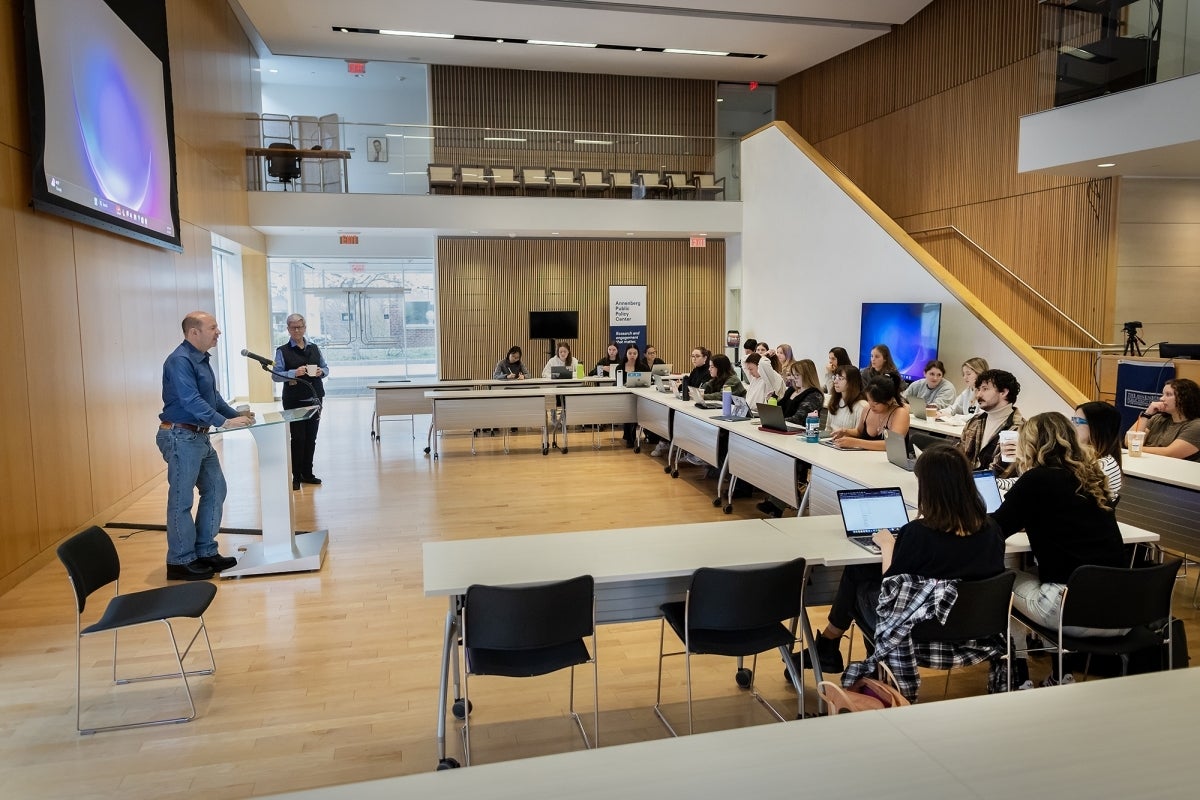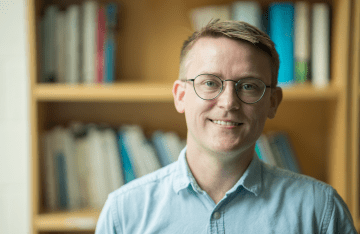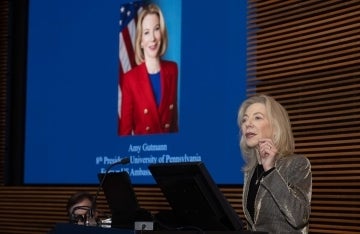Teaching Climate Change Communication, From the Classroom to a Conference of Journalists
Michael Mann and Kathleen Hall Jamieson are co-teaching the Climate Change and Communication course this spring, tied to the Society of Environmental Journalists annual conference, held this year at Penn.
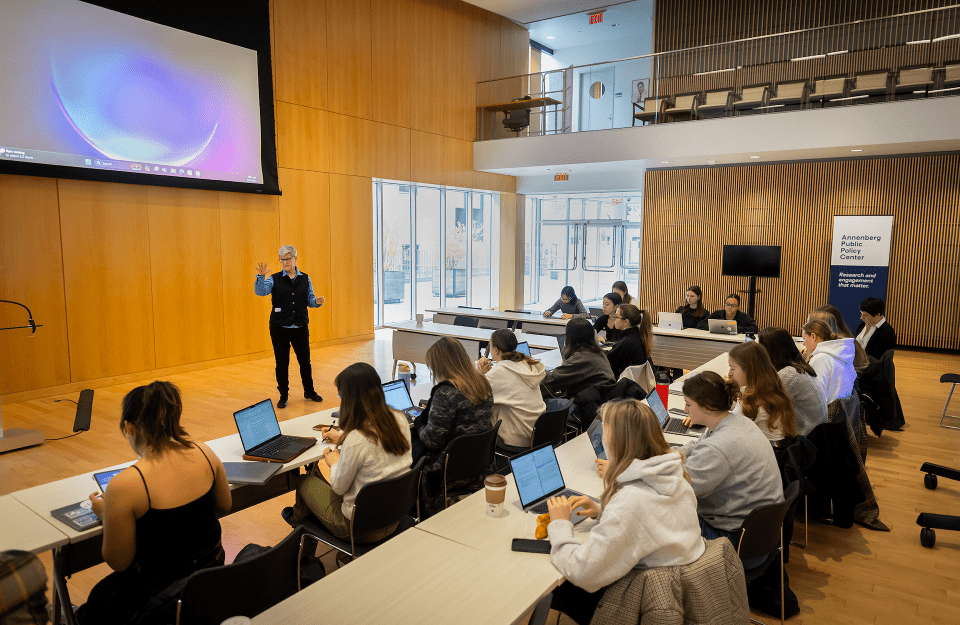
Michael Mann and Kathleen Hall Jamieson (pictured, standing) are co-teaching Climate Change and Communication to undergraduate and graduate students this semester. (Photo Credit: Eric Sucar)
When climate scientist Michael Mann was in talks to join the University of Pennsylvania faculty, he met with Kathleen Hall Jamieson, director of the Annenberg Public Policy Center, to ask if she would be interested in working with him if he came to Penn. Jamieson, a professor in the Annenberg School for Communication, enthusiastically said she would.
Fast forward to when the Society of Environmental Journalists (SEJ) approached Mann, now director of the Penn Center for Science, Sustainability, and the Media in the School of Arts & Sciences, about holding their annual conference on campus in April 2024. Once again, Mann reached out to Jamieson and the two faculty members decided to co-teach Climate Change and Communication, a spring course tied to the conference, which brought hundreds of journalists who study and produce environmental communication to campus.
This gave students the opportunity to interview journalists from outlets such as Inside Climate News, The Guardian, Vox, Mother Jones, and Mongabay.
At the first night of the conference, Jamieson sat onstage at the Zellerbach Theatre with Mann and Rick Weiss, director of SciLine, centering the student work from the Climate Communication class. Undergraduate and graduate students respectively identified six misconceptions and six conspiracy theories about climate change, Jamieson said, and worked to pinpoint scientific sources that would undermine the premises of these problematic notions.
The audience laughed as she directed them to a QR code on the screen behind her, as this was not the first time—and wouldn’t be the last—that she and Mann highlighted climate communication resources from APPC and PCSSM.
Combatting Misinformation and Disinformation
“The problem isn’t so much a deficit of information; it’s a surplus of misinformation, and that’s an important distinction that is far more relevant today than it was 10 years ago,” said Mann at a lunchtime session the first day of the SEJ conference. He was referring to a point he first made in 2013 at a conference on science communication sponsored by the American Association for the Advancement of Science. With climate change denial on the wane “because we can all see it’s happening,” Mann said bad actors are using other tactics: doomism, division, deflection, and delaying action.
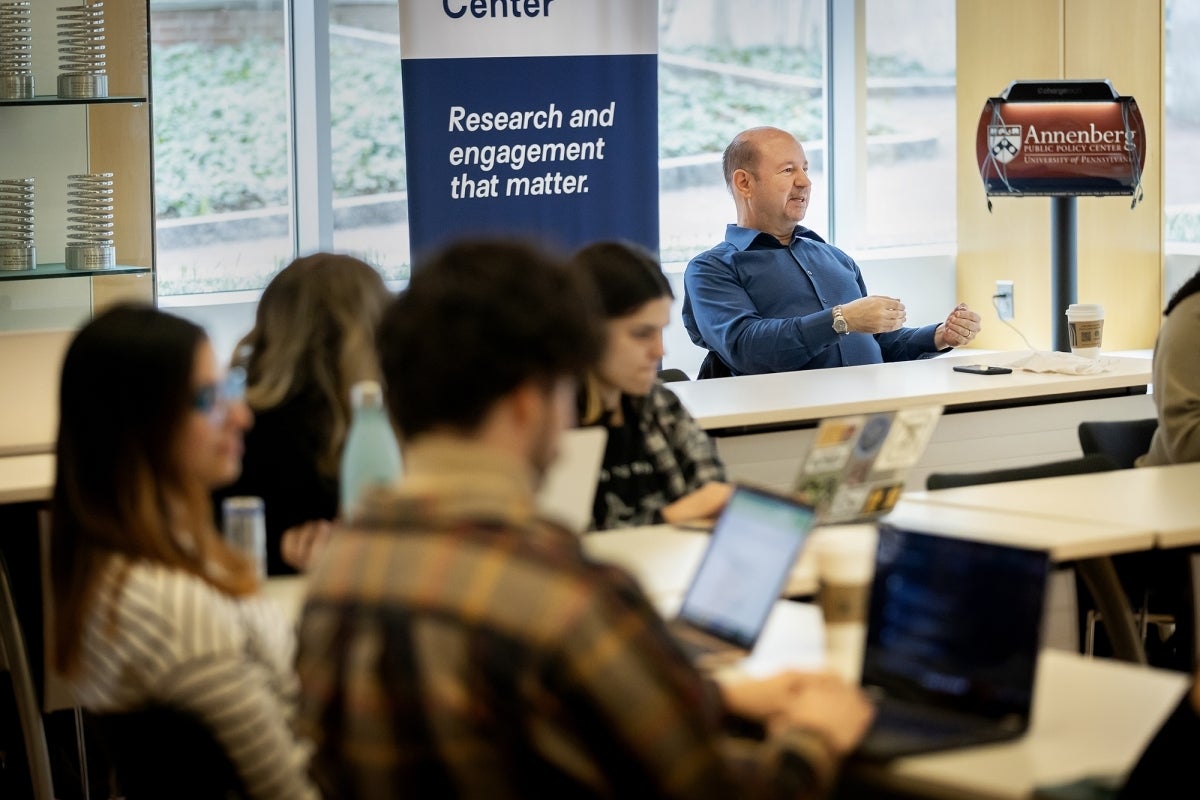
This session topic—“The Intersection Between Disinformation Research and Climate Science”—was also addressed in the Climate Change and Communication course. The 24 undergraduates split into groups to research climate misconceptions while the seven graduate students focused on conspiracy theories, all for collaborative white papers on “Leading Fallacies and Misframings in Climate Discourse.” In a class the week before the conference, one representative for each topic presented for five minutes before Jamieson and Mann gave one minute of feedback.
The undergrads focused on six myths: Individuals cannot make a meaningful difference, it’s too late to act, climate science knowledge is unreliable, solar and wind power are unacceptably costly and unreliable, climate change solutions cause problems for other parts of the ecosystem, and climate change is beneficial. The “it’s too late to act” fallacy is known as doomism, a notion that Mann has worked to refute through promoting “urgency and agency."
Third-year student Elizabeth Collins presented her group’s paper refuting the idea that climate change solutions such as wind farms, solar panels, and electric vehicles cause problems for other parts of the ecosystem. She noted that the National Ocean Industries Association and National Oceanic and Atmospheric Administration have found no credible link between offshore wind activities and whale mortalities, and she concluded with the benefits of offshore wind.
She also referenced discussion from earlier class periods on the “Six Americas,” a framing from the Yale Program on Climate Change Communication that categorizes people as alarmed, concerned, cautious, disengaged, doubtful, or dismissive about climate change.
Collins, a communication major from Phoenix, Arizona, says she was motivated to take this course after taking Introduction to Political Communication with Jamieson in the fall and feeling inspired by her vast knowledge. One of Collins’ biggest takeaways from this class, she says, is that “there are brilliant people who study climate change and do incredible research on it, but it doesn’t mean anything if you can’t communicate it.”
The course averaged one guest speaker a week, such as climate journalist Wolfgang Blau, Brown University climate scientist Kim Cobb, Associated Press science writer Seth Borenstein, and Philadelphia Inquirer national opinion columnist Will Bunch. Collins says the guest lectures showed her that it’s important to take climate change awareness and solutions into everyday careers, not only in scientific fields, because that’s how change is going to happen.

Students had to come up with concise questions for each guest that were grounded in assigned readings and based on the guest’s unique expertise. The class also included writing a letter to the editor, op-ed, and fact-check.
“We threw a lot at them, we’re asking a lot of them, but I feel like they’re rising to the occasion,” Mann said on the day of the white paper presentations. He said of the interplay between the course and SEJ conference, “The good is that it’s a unique opportunity. The bad is that it’s a unique opportunity. We can’t teach the same course a year from now.”
How Climate Language Matters
Annabelle Horton, a first-year doctoral student in earth and environmental science who is one of Mann’s Ph.D. students, says the class has been challenging but well worth the work, that students want to be engaged and get the professors’ perspectives.
“It’s been one of the most impactful classes I’ve taken as a science student, and I feel like I will use so much of what I’ve learned in my career, in the sense that it will definitely tweak how I write things,” says Horton, who is from Philadelphia. Her work in the Mann Research Group involves researching changes in the frequency and intensity of winter storms.
Horton says her biggest takeaways from the class are that “language matters so much more than we think,” and that “there is such a disparity between the language I’ve been using to describe science and the language that is accessible for the public.”
Horton says the class talked about using “pollutants” or “methane gases” instead of “greenhouse gases,” because the latter may lead people to think of the positive connotation of plants growing. She also notes that calling someone a “climate change denier” could make them defensive, which doesn’t help persuade.
Similarly, second-year Master of Environmental Studies student Mike Muldoon notes that “the term ‘conspiracy’ itself is something we use as a tool in the classroom,” but it’s better to use different language when communicating about these beliefs externally. He says each group in the Six Americas model has different communication needs, and that alienating skeptics with divisive language is unhelpful.
Muldoon, who is from Exton, Pennsylvania, says he has been struck by “the care with which both professors approach the topic of handling misinformation and the respect they pay to people who may have been misinformed.” He says the class also taught him about inoculation, explaining why misinformation is false to someone before the misinformation reaches them.
He says as a speechwriter for the Environmental Protection Agency, climate communication is a big part of what he does. Muldoon attended the SEJ conference as a Climate Communication class student, which included going to a training from SciLine on talking to the media, and as an EPA employee. He also watched the keynote from EPA Administrator Michael Regan.

At the conference, graduate students walked around with a badge below their name tags that read, “Ask me about debunking climate conspiracy theories.” The group flagged down a Wyoming journalist to ask him about misconceptions he deals with, whether he tries to refrain from language that might polarize readers, and what types of stories his audience likes best.
In class the week after the conference, undergraduate and graduate students shared what they learned from their journalist interviews: It’s important to balance reality and urgency with local stories that inspire action. It’s important to meet people where they are. There isn’t one single policy that would solve climate change, but there’s a compounding effect.
The next steps for the students were to incorporate the information from journalists into their white paper contributions and film a video explainer of their insights, with help from the Annenberg Media Lab.
“They’re actually producing communication in the context of theory about communication,” Jamieson says. “Teach the course from a climate science perspective without a focus on communication theory, and the students’ white papers and videos might not be as persuasive as they could be. Teach it from a communication theory perspective alone, and the students might inadvertently misrepresent the climate science.”
Michael Mann is a Presidential Distinguished Professor, with joint appointments in the Department of Earth and Environmental Science in the School of Arts & Sciences and the Annenberg School for Communication, and the director of the Penn Center for Science, Sustainability, and the Media in the School of Arts & Sciences.
Kathleen Hall Jamieson is the Elizabeth Ware Packard Professor of Communication at the Annenberg School for Communication, director of the Annenberg Public Policy Center, and co-founder of FactCheck.org.
